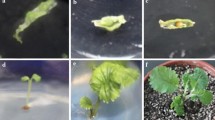Abstract
Four new accessions (BSP1-4) of rose scentedgeranium Pelargonium graveolens were derivedfrom the spontaneous half-sib seed progeny of mostly sterilepopulations of the cultivar accession Bipuli. The seed producingplants of Bipuli had been growing among the populations of cultivaraccessions Hemanti and Kunti in the temperate agroclimate ofKodaikanal, Tamilnadu in India. The four new accessions were comparedwith the cultivar accessions Bipuli, Hemanti and Kunti in fieldexperiments under subtropical agroclimate of Lucknow, Uttar Pradeshfor essential oil yield and quality related traits and in terms oftheir RAPD profiles. The crop yield and essential oil parameters andDNA profiles of the four new accessions and three cultivar accessionsallowed the conclusion that the accessions BSP-1, BSP-2 andBSP-3 were Bipuli × Kunti hybrids and BSP-4was a Bipuli × Hemanti hybrid. The accession BSP-4demonstrated hybrid vigour in several of the essential oil yieldrelated traits; on average basis it out yielded other accessions by afactor of about 2.4. The essential oil of BSP-4 had 89%rhodinol content in which citronellol to geraniol ratio was 1:1 andthe contents of isomenthone, menthone, 10-epi--eudesmol, 6,9-guaiadiene, decanoic acid andisodecanoic acid were relatively lower than in the oils of accessionsBipuli and/or Hemanti. The present study has shown a way for thegeneration of new genotypes in rose scented geranium in which thecultivars have been vegetatively maintained for decades and thegenetic resources are scanty.
Similar content being viewed by others
References
Adams R.P. 1990. Identification of Essential Oils by Ion Trap Mass Spectroscopy. Academic Press, San Diego, CA.
Gulati B.C. 1960. Cultivation of geranium. Indian Oil Soap Journal 26(2): 35–43.
Jennings W. and Shibmoto T. 1980. Qualitative Analysis of Flavour and Fragrant Volatiles by Glass Capillary Column Gas Chroma-tography. Acad. Press, New York.
Khanuja S.P.S., Shasany A.K., Darokar M.P. and Kumar S. 1999. Rapid isolation of PCR amplifiable DNA from dry and fresh samples of plant producing large amounts of secondary metabo-lites and essential oil by modified CTAB procedure. Plant Molecular Biology 17: 74.
Lawrence B.M. 1984. Progress in essential oils. Perfumer and Flavorist 9: 987–995.
Lis-Balchin M. and Deans S.G. 1996. Anti-microbial effects of hydrophilic extracts of Pelargonium species (Geraniaceae). Letters in Applied Microbiogy 24(4): 205–207.
Matsuda B.M., Surgeoner G.A., Heal J.D., Tucker A.O. and Maciarello M.J. 1996. Essential oil analysis and field evaluation of citrosa plant 'P. citrosum' as a repellent against population of Aedes mosquito. Journal of the American Mosquito Control Association 12(1): 69–74.
Nei M. and Li W.H. 1979. Mathematical model for studying genetic variation in terms of restriction endonuclease. Proc. Natl. Acad. Sci. U.S.A. 74: 5267–5273.
Pellegrineschi A. and Mariani O.D. 1996. Agrobacterium rhizogenes mediated transformation of scented geranium. Plant Cell, Tissue and Organ Culture 47: 79–86.
Pellegrineschi A., Damon J.-P., Valtorta N., Paillard N. and Tepfer D. 1994. Improvement of ornamental characters and fragrance production in lemon-scented geranium through genetic trans-formation by Agrobacterium rhizogenes. Biotechnology 12: 64–68.
Qinghua Z. 1993. China's perfumery industry picks up. Perfumer and Flavorist 18: 47–48.
Rajeswara Rao B.R., Rao E.V.S.P. and Narayana M.R. 1989. Rose geranium: An economical crop in the south Indian Plains. Indian Horticulture 36(2): 14–17.
Ram M., Gupta M.M., Naqvi A.A. and Kumar S. 1995. Commer, cially viable annual crop of geranium in northern Indian plains. Current Research on Medicinal and Aromatic Plants. Journal of Medicinal and Aromatic Plant Sciences 17: 17–20.
Sarwar M. and Khan M.N.A. 1972. Diseases and pests of aromatic plants from south India. Angew. Bot. 45(4/6): 211–216.
Saxena G., Banerjee S. and Kumar S. 2000. Generation of essential oil quality variants by Agrobacterium rhizogenes mediated Ri-insertion in rose scented geranium. Pelargonium sp. (communicated).
Saxena G., Banerjee S., Rahman L., Mallavarapu G.R., Sharma S. and Kumar S. 2000. An efficient in vitro procedure for micro-propagation and generation of somaclones of rose scented Pelar-gonium. Plant Science 155: 133–140.
Skirvin M. and Janick J. 1976. Velvet rose, Pelargonium a scented geranium. Hort. Sci. 11: 61–62.
Vanderwalt J.J.A. and Vorster P.J. 1988. Pelargoniums of southern Africa. National Botanic Gardens, Kirtenbosch. Vol 3.
Author information
Authors and Affiliations
Rights and permissions
About this article
Cite this article
Gupta, R., Sastry, K., Banerjee, S. et al. Genetic resource enhancement by isolation of diversegenotypes from seed progeny in predominantly sterile rose scentedgeranium Pelargonium graveolens . Genetic Resources and Crop Evolution 48, 629–636 (2001). https://doi.org/10.1023/A:1013869025606
Issue Date:
DOI: https://doi.org/10.1023/A:1013869025606




